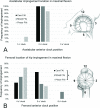Femoral impingement in maximal hip flexion is anterior-inferior distal to the cam deformity in femoroacetabular impingement patients with femoral retroversion : implications for hip arthroscopy
- PMID: 36620909
- PMCID: PMC9872041
- DOI: 10.1302/2046-3758.121.BJR-2022-0263.R1
Femoral impingement in maximal hip flexion is anterior-inferior distal to the cam deformity in femoroacetabular impingement patients with femoral retroversion : implications for hip arthroscopy
Abstract
Aims: Femoroacetabular impingement (FAI) patients report exacerbation of hip pain in deep flexion. However, the exact impingement location in deep flexion is unknown. The aim was to investigate impingement-free maximal flexion, impingement location, and if cam deformity causes hip impingement in flexion in FAI patients.
Methods: A retrospective study involving 24 patients (37 hips) with FAI and femoral retroversion (femoral version (FV) < 5° per Murphy method) was performed. All patients were symptomatic (mean age 28 years (SD 9)) and had anterior hip/groin pain and a positive anterior impingement test. Cam- and pincer-type subgroups were analyzed. Patients were compared to an asymptomatic control group (26 hips). All patients underwent pelvic CT scans to generate personalized CT-based 3D models and validated software for patient-specific impingement simulation (equidistant method).
Results: Mean impingement-free flexion of patients with mixed-type FAI (110° (SD 8°)) and patients with pincer-type FAI (112° (SD 8°)) was significantly (p < 0.001) lower compared to the control group (125° (SD 13°)). The frequency of extra-articular subspine impingement was significantly (p < 0.001) increased in patients with pincer-type FAI (57%) compared to cam-type FAI (22%) in 125° flexion. Bony impingement in maximal flexion was located anterior-inferior at femoral four and five o'clock position in patients with cam-type FAI (63% (10 of 16 hips) and 37% (6 of 10 hips)), and did not involve the cam deformity. The cam deformity did not cause impingement in maximal flexion.
Conclusion: Femoral impingement in maximal flexion was located anterior-inferior distal to the cam deformity. This differs to previous studies, a finding which could be important for FAI patients in order to avoid exacerbation of hip pain in deep flexion (e.g. during squats) and for hip arthroscopy (hip-preservation surgery) for planning of bone resection. Hip impingement in flexion has implications for daily activities (e.g. putting on shoes), sports, and sex.Cite this article: Bone Joint Res 2023;12(1):22-32.
Keywords: CT scans; Extra-articular hip impingement; FAI; Femoroacetabular impingement; Hip arthroscopy; Hip preservation surgery; Subspine impingement; cam deformities; cam-type femoroacetabular impingement; femoral retroversion; femoroacetabular impingement; flexion; hip arthroscopy; hip flexion; hip pain; hips.
Figures





Similar articles
-
Hip Impingement Location in Maximal Hip Flexion in Patients With Femoroacetabular Impingement With and Without Femoral Retroversion.Am J Sports Med. 2022 Sep;50(11):2989-2997. doi: 10.1177/03635465221110887. Epub 2022 Aug 29. Am J Sports Med. 2022. PMID: 36037094
-
Femoroacetabular Impingement Patients With Decreased Femoral Version Have Different Impingement Locations and Intra- and Extraarticular Anterior Subspine FAI on 3D-CT-Based Impingement Simulation: Implications for Hip Arthroscopy.Am J Sports Med. 2019 Nov;47(13):3120-3132. doi: 10.1177/0363546519873666. Epub 2019 Sep 20. Am J Sports Med. 2019. PMID: 31539275
-
Large Hip Impingement Area and Subspine Hip Impingement in Patients With Absolute Femoral Retroversion or Decreased Combined Version.Orthop J Sports Med. 2023 Feb 22;11(2):23259671221148502. doi: 10.1177/23259671221148502. eCollection 2023 Feb. Orthop J Sports Med. 2023. PMID: 36846812 Free PMC article.
-
[Torsional deformities of the femur in patients with femoroacetabular impingement : Dynamic 3D impingement simulation can be helpful for the planning of surgical hip dislocation and hip arthroscopy].Orthopade. 2020 Jun;49(6):471-481. doi: 10.1007/s00132-019-03847-x. Orthopade. 2020. PMID: 31853580 Review. German.
-
Hip Arthroscopy for Femoroacetabular Impingement-Associated Labral Tears: Current Status and Future Prospects.Orthop Res Rev. 2022 Apr 21;14:121-132. doi: 10.2147/ORR.S253762. eCollection 2022. Orthop Res Rev. 2022. PMID: 35480069 Free PMC article. Review.
Cited by
-
Hip joint contact pressure and force: a scoping review of in vivo and cadaver studies.Bone Joint Res. 2023 Dec 4;12(12):712-721. doi: 10.1302/2046-3758.1212.BJR-2022-0461.R2. Bone Joint Res. 2023. PMID: 38043570 Free PMC article.
-
Sex-Based Differences and Asymmetry in Hip Kinematics During Unilateral Extension From Deep Hip Flexion.J Biomech Eng. 2024 Dec 1;146(12):124501. doi: 10.1115/1.4066466. J Biomech Eng. 2024. PMID: 39262043

